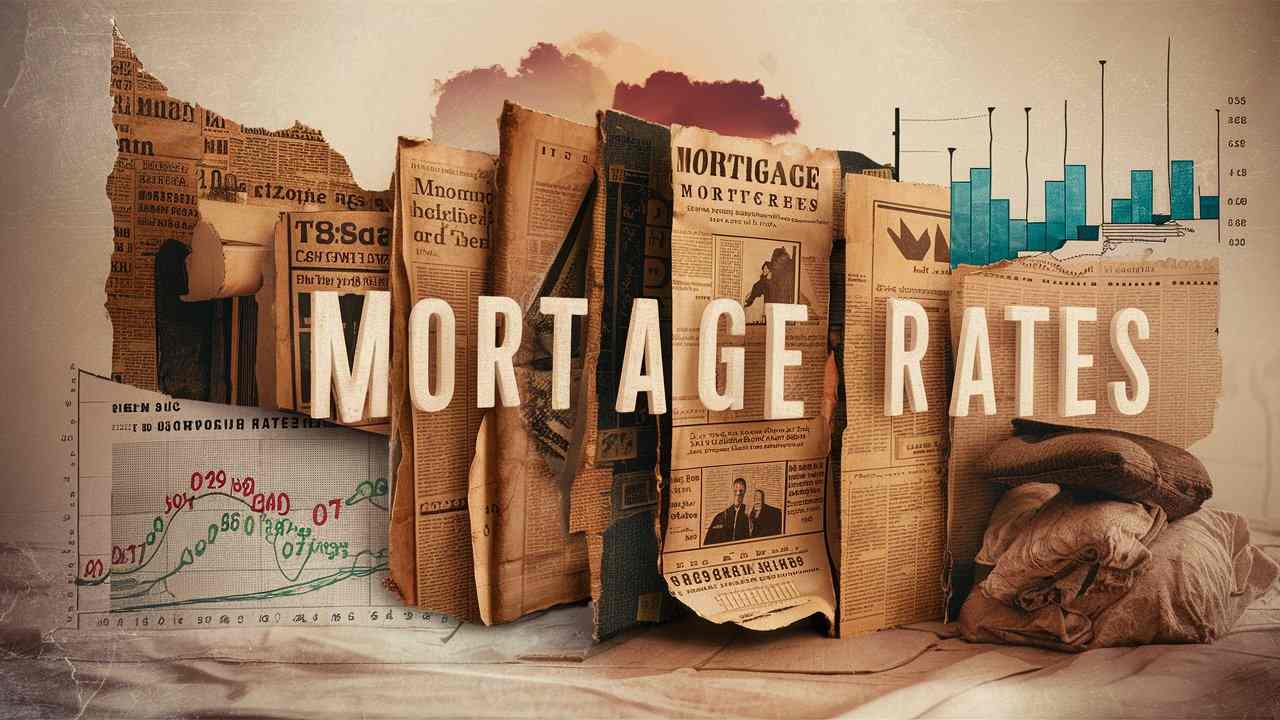Introduction
The Curious Case of Historical Mortgage Rates: What’s the Big Deal?
Mortgage rates might seem as dull as watching paint dry, but their historical journey is nothing short of riveting. Picture mortgage rates as a roller coaster with wild dips and climbs, influenced by economic shifts and policy changes. Understanding these rates is like having a treasure map to the best deals on your next home loan.

Why Understanding Historical Rates Can Save You Big Bucks
Grasping the twists and turns of historical mortgage rates isn’t just academic $ it’s practical. Savvy homebuyers and investors who track these trends can dodge financial pitfalls and snag better deals. Why pay more when you can use the past to predict a cheaper future?
Who Should Care About Mortgage Rates? Homebuyers, Refinancers, and Market Watchers
Whether you’re hunting for your first home, looking to refinance, or simply a market enthusiast, historical mortgage rates are your financial crystal ball. They provide insights that are crucial for making well-informed decisions, no matter where you stand in the property game.
The Evolution of Mortgage Rates
A Brief History of Mortgage Rates: From the 1970s to Today
Mortgage rates have had quite the journey, from the sky-high figures of the 1970s to the more reasonable rates of recent years. This section dives into how these rates have evolved, reflecting broader economic conditions and changing financial policies.
How Major Events Shaped Mortgage Rates Over the Decades
The trajectory of mortgage rates hasn’t been a straight line. Major events $ like the 1970s oil crisis, the 2008 financial meltdown, and recent global disruptions $ have all played a part in shaping today’s rates. These events act as dramatic plot points in the ongoing story of mortgage finance.

The Rise and Fall of Mortgage Rates: Key Historical Milestones
From the jaw-dropping highs of the early 1980s to the lows seen in recent years, mortgage rates have seen dramatic changes. Highlighting these milestones helps us understand the forces behind these fluctuations and what they mean for today’s market.
Understanding Mortgage Rate Trends
The Basics of Mortgage Rates: What Drives Them Up and Down?
mortgage ratesare influenced by a myriad of factors, including economic indicators, inflation, and the Federal Reserve’s policies. This section breaks down the core elements that push rates up and pull them down, offering a clear picture of what drives these financial shifts.
How Inflation and Economic Policies Impact Mortgage Rates
Inflation and economic policies don’t just sound important $ they are. These elements can make or break mortgage rates, By understanding their impact, you can better anticipate rate changes and make more strategic financial decisions.
The Role of the Federal Reserve: Interest Rates and Mortgage Rates
The Federal Reserve’s decisions are like a steering wheel for mortgage rates. When the Fed changes interest rates, mortgage rates often follow suit. This section explores how Fed actions influence your borrowing costs.
Notable Historical Mortgage Rate Periods
The 1980s: When Mortgage Rates Were Sky-High
The 1980s were a wild ride for mortgage rates, reaching unprecedented heights. Discover what drove these extreme rates and how they affected borrowers at the time.
The Early 2000s: A Low-Rate Haven and Its Consequences
In the early 2000s, mortgage rates hit rock bottom, sparking a home-buying frenzy. But what were the long-term impacts of these low rates? This section delves into the consequences of this low-rate environment.
The 2008 Financial Crisis: How Mortgage Rates Reacted
The 2008 crisis was a financial earthquake that rattled mortgage rates. Learn how this period of turmoil reshaped mortgage finance and what lessons were learned.

How Historical Mortgage Rates Affect Your Finances
The Impact of High Mortgage Rates on Your Monthly Payments
High mortgage rates can make monthly payments soar. This section explores how these rates can affect your budget and what you can do to manage the financial strain.
Why Lower Historical Rates Can Be a Double-Edged Sword
While lower rates might seem like a boon, they can sometimes lead to inflated home prices and other economic distortions. This section explains why lower rates aren’t always the panacea they appear to be.
How Long-Term Trends Can Influence Your Mortgage Strategy
Long-term trends in mortgage rates can offer invaluable insights for crafting your mortgage strategy. Learn how to use historical data to make informed decisions about your home loan.
Comparing Historical Rates to Current Rates
Current Mortgage Rates vs. Historical Rates: What’s Normal?
Is today’s mortgage rate a bargain or a rip-off? Comparing current rates with historical benchmarks helps determine what’s typical and what’s exceptional.
Lessons Learned from Past Rate Trends: What Can We Expect?
Past mortgage rate trends provide clues about future movements. This section uses historical data to predict what might come next in the mortgage market.
The Impact of Historical Rates on Today’s Home Buying Decisions
Understanding historical rates can guide your current home-buying decisions. Learn how to use past data to navigate today’s mortgage landscape more effectively.
Refinancing and Historical Rates
Refinancing Trends Through the Ages: How Historical Rates Influence Decisions
Refinancing trends have shifted over the decades based on mortgage rate changes. This section explores how historical rates have shaped refinancing strategies.
When to Refinance Based on Historical Rate Trends
Timing is crucial for refinancing. This section offers advice on when to refinance by looking at patterns from past mortgage rate movements.
The Best Times to Refinance: Insights from Past Data
Historical data provides clues on the optimal times to refinance. Discover the best moments to refinance based on past trends and current conditions.
Regional Variations in Historical Mortgage Rates
How Different Regions Experienced Mortgage Rate Fluctuations
Mortgage rates haven’t been uniform across the U.S. This section looks at how different regions have experienced rate fluctuations and what that means for local markets.
Regional Economic Factors and Their Influence on Mortgage Rates
Local economic factors can significantly impact mortgage rates. Learn how regional economies influence rates and what it means for prospective borrowers.
Comparing Historical Mortgage Rates Across U.S. States
Explore how historical mortgage rates compare across various states and regions, providing a broader view of how rates have varied geographically.
How to Use Historical Data in Your Mortgage Planning
Analyzing Historical Data: Tools and Resources for Homebuyers
Various tools and resources can help analyze historical mortgage data. This section offers guidance on how to use these tools to inform your mortgage planning.
Predicting Future Mortgage Trends Based on Past Data
Historical data can be a powerful predictor of future trends. Learn how to leverage past information to forecast future mortgage rate movements.
Crafting a Mortgage Strategy with Historical Insights
Developing a mortgage strategy informed by historical data can enhance your financial planning. This section provides tips on how to craft a strategy that leverages past trends.
The Psychological Impact of Mortgage Rate Trends
How Historical Rates Influence Buyer Sentiment and Behavior
Mortgage rate trends can impact buyer sentiment. This section explores how past rate movements affect how people feel about buying and borrowing.
The Emotional Rollercoaster of Mortgage Rate Fluctuations
Mortgage rate fluctuations can be an emotional ride. Learn how these ups and downs affect borrowers on a psychological level.
Understanding the Psychological Impact on Home Buyers and Refinancers
Understanding the psychological impact of mortgage rates can help in managing the emotional aspects of buying or refinancing a home.
Real-Life Stories and Case Studies
Success Stories: How Homebuyers Benefited from Historical Rate Trends
Real-life success stories show how understanding historical rates can lead to significant financial gains. This section shares inspiring examples of savvy homebuyers.
Lessons from the Past: Real-Life Examples of Mortgage Decisions
Historical decisions offer valuable lessons. Discover how past mortgage choices have shaped financial outcomes and what can be learned from them.
What Can We Learn from Historical Rate-Driven Financial Outcomes?
Analyzing historical financial outcomes provides insights into effective mortgage strategies. Learn what can be gleaned from past experiences to improve future decisions.
Expert Opinions and Predictions
Insights from Economists: Predictions for Future Mortgage Rates
Economists offer predictions based on historical trends and current data. This section provides expert insights into where mortgage rates might be headed.
Expert Analysis of Historical Trends and Future Outlook
Experts analyze historical trends to predict future movements. Discover what the experts are saying about the future of mortgage rates.
What Mortgage Experts Say About Historical Rates and Market Trends
Mortgage experts share their views on how historical rates and market trends will shape the future. This section offers valuable perspectives for navigating mortgage decisions.
Tips for Navigating Mortgage Rates Today
How to Apply Historical Insights to Your Current Mortgage Situation
Applying historical insights to your current mortgage situation can improve your financial strategy. Learn practical tips for using past data to make smarter decisions.
Strategies for Securing the Best Rate Based on Historical Data
Securing the best mortgage rate involves strategic planning. This section provides strategies for using historical data to negotiate better rates.
Common Pitfalls to Avoid When Dealing with Mortgage Rates
Avoiding common pitfalls can save you from costly mistakes. Discover what to watch out for when dealing with mortgage rates and how to avoid common errors.
BOTTOM LINE
Summing Up: Key Takeaways from Historical Mortgage Rates
Summarize the key lessons from historical mortgage rates and their relevance. This section wraps up the insights gained from exploring the past.
Final Thoughts: How to Use Historical Data to Your Advantage
Final thoughts on leveraging historical data for financial benefits. Learn how to apply the insights from historical mortgage rates to enhance your decision-making.
Next Steps: Implementing What You’ve Learned About Mortgage Rates
Take action based on what you’ve learned about mortgage rates. This section provides guidance on the next steps for applying historical insights to your mortgage strategy.
Frequently Asked Questions (FAQs)
How have historical mortgage rates changed over the past 50 years?
Historical mortgage rates have seen significant fluctuations over the past five decades. In the 1970s, rates were relatively high, driven by inflationary pressures. The early 1980s witnessed the peak of mortgage rates, with averages reaching over 18% due to aggressive Federal Reserve policies aimed at curbing inflation. The 1990s and early 2000s saw a steady decline, with rates falling to around 6% by the end of the 2000s. The 2010s brought historically low rates, often below 4%, as central banks implemented low-interest policies to stimulate economic growth. The COVID-19 pandemic further pushed rates to near-record lows.
What factors influence historical mortgage rates?
Historical mortgage rates are influenced by several key factors:
- Inflation: Higher inflation typically leads to higher mortgage rates as lenders demand higher returns to offset the decrease in purchasing power.
- Economic Growth: Strong economic growth can lead to higher rates due to increased demand for credit.
- Federal Reserve Policies: Changes in the Federal Reserve’s key interest rates directly impact mortgage rates.
- Global Economic Conditions: International events and economic conditions can affect investor behavior and influence mortgage rates.
- Market Demand: Supply and demand dynamics in the mortgage market also play a crucial role.
How did the 2008 financial crisis affect mortgage rates?
The 2008 financial crisis led to a significant drop in mortgage rates. During the crisis, the Federal Reserve slashed interest rates to near zero in an effort to stimulate the economy and stabilize the financial system. This action, combined with a flight to safety by investors, led to historically low mortgage rates. The rate cuts were intended to encourage borrowing and investing, helping to revive the housing market and broader economy. Source
What were mortgage rates like during the 1980s?
The 1980s were characterized by exceptionally high mortgage rates. During this decade, rates soared due to high inflation and the Federal Reserve’s tight monetary policies aimed at controlling it. In 1981, the average 30-year fixed mortgage rate peaked at over 18%, making homeownership more expensive and less accessible for many. This period of high rates significantly impacted the housing market and borrowing costs.
How do historical mortgage rates compare to current rates?
Current mortgage rates are generally much lower compared to historical averages, particularly when compared to the rates seen in the late 1970s and early 1980s. Recent years have seen rates dip below 4%, reaching near-record lows during the COVID-19 pandemic. This is in stark contrast to the double-digit rates of the past, reflecting a long-term trend of lower borrowing costs.
What impact did the COVID-19 pandemic have on mortgage rates?
The COVID-19 pandemic had a profound impact on mortgage rates, driving them to near-record lows. In response to the economic uncertainty and disruptions caused by the pandemic, the Federal Reserve implemented aggressive monetary policies, including lowering interest rates and purchasing mortgage-backed securities. These measures, combined with decreased economic activity, led to historically low mortgage rates, providing an opportunity for borrowers to secure more affordable financing.
How can historical mortgage rates help in deciding when to refinance?
Historical mortgage rates can provide valuable context for making refinancing decisions. By comparing current rates to historical trends, borrowers can assess whether they might benefit from refinancing. If current rates are significantly lower than past averages or previous rates on a loan, refinancing may reduce monthly payments or overall interest costs. Historical data helps in understanding market cycles and timing the refinance to maximize savings.
What are the long-term trends in mortgage rates?
Long-term trends in mortgage ratess have generally shown a decline from the high levels of the early 1980s to the lower levels observed in recent years. After reaching peak levels in the 1980s, rates have gradually decreased, influenced by falling inflation, changes in Federal Reserve policies, and evolving economic conditions. This trend reflects broader shifts in monetary policy and economic cycles.
How do historical mortgage rates affect home buying decisions today?
Historical mortgage rates can influence home buying decisions by providing context for current rates and market conditions. When rates are historically low, it can encourage buyers to enter the market or upgrade their homes, as borrowing costs are more affordable. Conversely, high historical rates can highlight the relative advantage of current low rates, motivating buyers to take advantage of favorable conditions.
What were the lowest mortgage rates recorded historically?
The lowest mortgage rates recorded historically occurred during the COVID-19 pandemic, with 30-year fixed mortgage rates dipping below 3%. This represents a significant decline from previous lows and reflects the unprecedented economic conditions and monetary policy responses during the pandemic.
Source: Freddie Mac
How did the 1970s stagflation period impact mortgage rates?
The 1970s stagflation period, characterized by high inflation and stagnant economic growth, led to sharply rising mortgage rates. To combat inflation, the Federal Reserve raised interest rates, resulting in higher borrowing costs. This period saw mortgage rates climb significantly, reaching levels above 10%, which had a substantial impact on housing affordability and market activity.
How do historical mortgage rates vary by region?
Historical mortgage ratescan vary significantly by region due to local economic conditions, housing market dynamics, and regional lending practices. While national averages provide a general sense of trends, regional variations reflect differences in economic conditions, housing demand, and local financial markets.
What role do historical mortgage rates play in forecasting future rates?
Historical mortgage rates are instrumental in forecasting future rates as they provide a basis for understanding long-term trends and cycles. By analyzing past rate movements and their causes, analysts can make informed predictions about future trends. Historical data helps in identifying patterns and potential influences on future mortgage rate changes.
How did economic recessions impact mortgage rates historically?
Economic recessions typically lead to lower mortgage rates as central banks implement monetary policy measures to stimulate the economy. During recessions, the Federal Reserve often cuts interest rates to encourage borrowing and spending. Historical recessions, such as those in 2001 and 2008, saw significant reductions in mortgage rates as part of broader economic stabilization efforts.
What historical events caused the most significant spikes in mortgage rates?
Significant spikes in mortgage rateshave historically been driven by events such as the 1970s oil crisis, high inflation periods, and aggressive Federal Reserve policies. The early 1980s, in particular, experienced the most notable spike, with mortgage rates exceeding 18% as the Federal Reserve sought to control rampant inflation.
How can historical mortgage rates data be accessed?
Historical mortgage rates data can be accessed through various sources, including financial news websites, government agencies such as the Federal Reserve, and specialized financial data providers. Websites like Freddie Mac and FRED (Federal Reserve Economic Data) offer comprehensive historical mortgage rate data for analysis and comparison.
Source: Freddie Mac Historical Data
How did the Federal Reserve’s policies impact historical mortgage rates?
The Federal Reserve’s policies have had a significant impact on historical mortgage rates. Through its control of short-term interest rates and open market operations, the Fed influences overall borrowing costs, including mortgage rates. Periods of high rates, such as in the early 1980s, were driven by the Fed’s actions to combat inflation, while low rates in recent years reflect efforts to stimulate economic growth.
What were mortgage rates like in the early 2000s compared to today?
In the early 2000s, mortgage rates were relatively high compared to today’s rates. Rates fluctuated between 5% and 7% during that period. In contrast, recent years have seen rates drop below 4%, and even lower during the COVID-19 pandemic, highlighting a significant decline in borrowing costs over the past two decades.
How can understanding historical mortgage rates help in negotiating a mortgage?
Understanding historical mortgage rates provides context for negotiating a mortgage by highlighting how current rates compare to past trends. Knowledge of historical lows and highs can empower borrowers to negotiate better terms or identify favorable borrowing opportunities. It also helps in assessing whether the current rate offers a good deal relative to historical averages.









